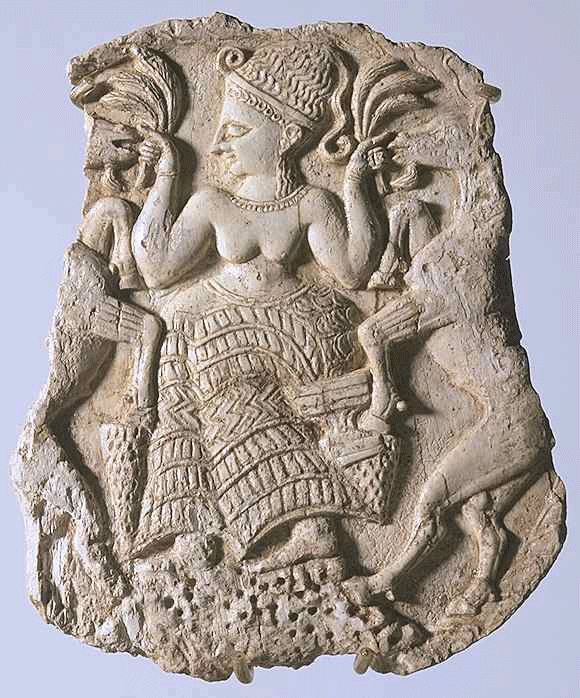
Asherah, Athirat
We may reasonably assume that the analogy drawn from the process of reproduction among men and animals led to the conception of a female deity presiding over the life of the universe. The extension of the scope of this goddess to life in general - to the growth of plants and trees from the fructifying seed - was a natural outcome of a fundamental idea; and so, whether we turn to incantations or hymns, in myths and in epics, in votive inscriptions and in historical annals, Ishtar is celebrated and invoked as the great mother, as the mistress of lands, as clothed in splendor and power - one might almost say as the personification of life itself.
But there are two aspects to this goddess of life. She brings forth, she fertilizes the fields, she clothes nature in joy and gladness, but she also withdraws her favors and when she does so the fields wither, and men and animals cease to reproduce. In place of life, barrenness and death ensue. She is thus also a grim goddess, at once cruel and destructive. We can, therefore, understand that she was also invoked as a goddess of war and battles and of the chase; and more particularly among the warlike Assyrians she assumes this aspect.
Before the battle she appears to the army, clad in battle array and armed with bow and arrow. In myths symbolizing the change of seasons she is portrayed in this double character, as the life-giving and the life-depriving power. The most noteworthy of these myths describes her as passing through seven gates into the nether world.
At each gate some of her clothing and her ornaments are removed until at the last gate she is entirely naked. While she remains in the nether world as a prisoner - whether voluntary or involuntary it is hard to say - all fertility ceases on Earth, but the time comes when she again returns to Earth, and as she passes each gate the watchman restores to her what she had left there until she is again clad in her full splendor, to the joy of mankind and of all nature.
Closely allied with this myth and personifying another view of the change of seasons is the story of Ishtar's love for her son and consort Tammuz - symbolizing the spring time - but as midsummer approaches her husband is slain and, according to one version, it is for the purpose of saving Tammuz from the clutches of the goddess of the nether world that she enters upon her journey to that region.
She is a life-death-rebirth deity.
In all the great centres Ishtar had her temples, bearing such names as E-anna, "heavenly house," in Erech; E-makh, "great house," in Babylon; E-mash-mash, "house of offerings," in Nineveh. Of the details of her cult we as yet know little, but there is no evidence that there were obscene rites connected with it, though there may have been certain mysteries introduced at certain centres which might easily impress the uninitiated as having obscene aspects. She was served by priestesses as well as by priests, and it would appear that the votaries of Ishtar were in all cases virgins who, as long as they remained in the service of Ishtar, were not permitted to marry.
In the astral-theological system, Ishtar becomes the planet Venus, and the double aspect of the goddess is made to correspond to the strikingly different phases of Venus in the summer and winter seasons. On monuments and seal-cylinders she appears frequently with how and arrow, though also simply clad in long robes with a crown on her head and an eight-rayed star as her symbol.
Statuettes have been found in large numbers representing her as naked with her arms folded across her breast or holding a child. The art thus reflects the popular conceptions formed of the goddess. Together with Sin, the Moon god, and Shamash, the Sun god, she is the third figure in a triad personifying the three great forces of nature - Moon, Sun and Earth, as the life-force. The doctrine involved illustrate, the tendency of the Babylonian priests to centralize the manifestations of divine power in the universe, just as the triad Anu, Bel and ha - the heavens, the earth and the watery deep - form another illustration of this same tendency.
Naturally, as a member of a triad, Ishtar is dissociated from any local limitations, and similarly as the planet Venus - a conception which is essentially a product of theological speculation - no though of any particular locality for her cult is present. It is because the cult, like that of Sin and Shamash, is spread over al Babylonia and Assyria, that she becomes available for purposes of theological speculation.